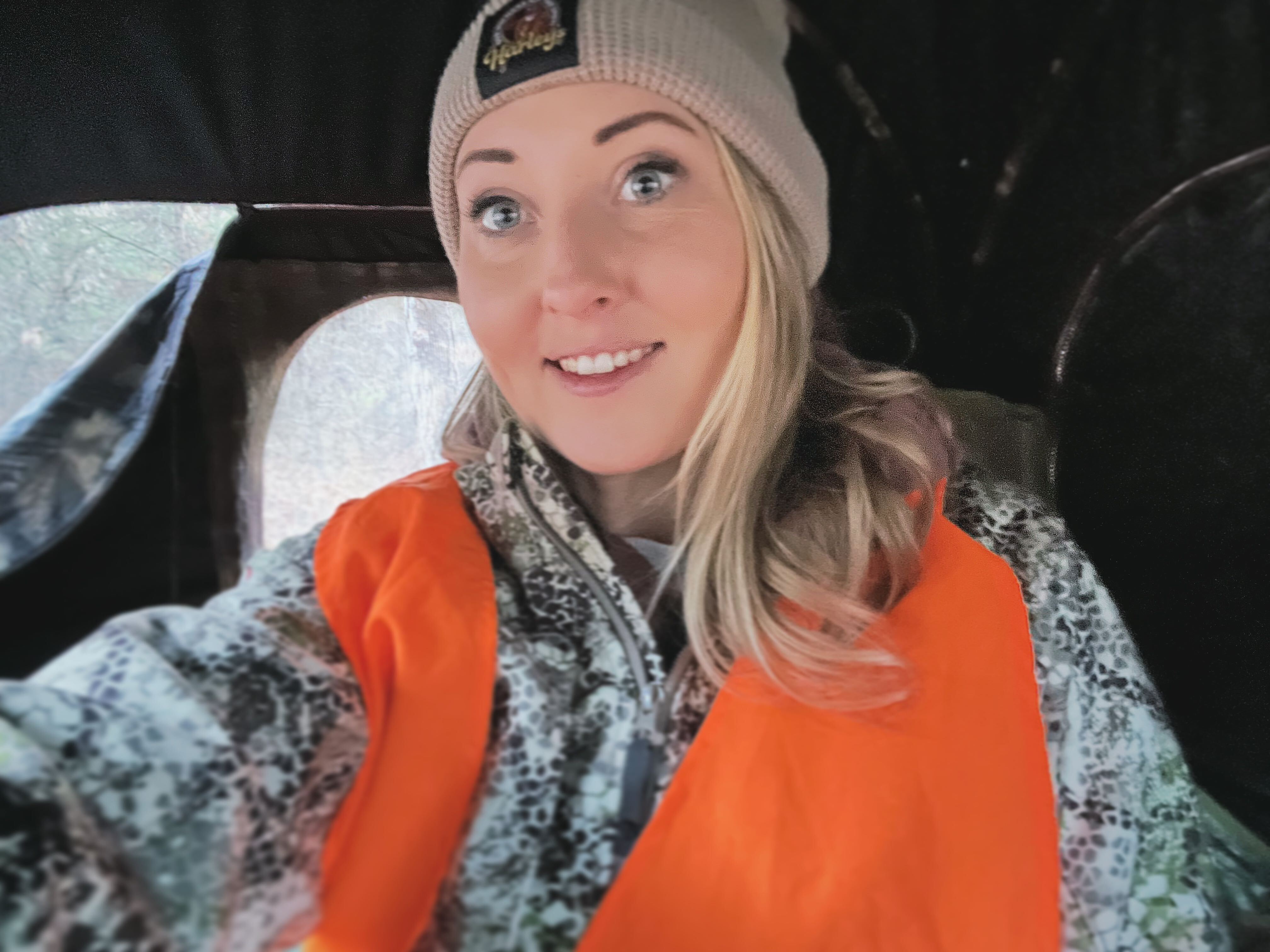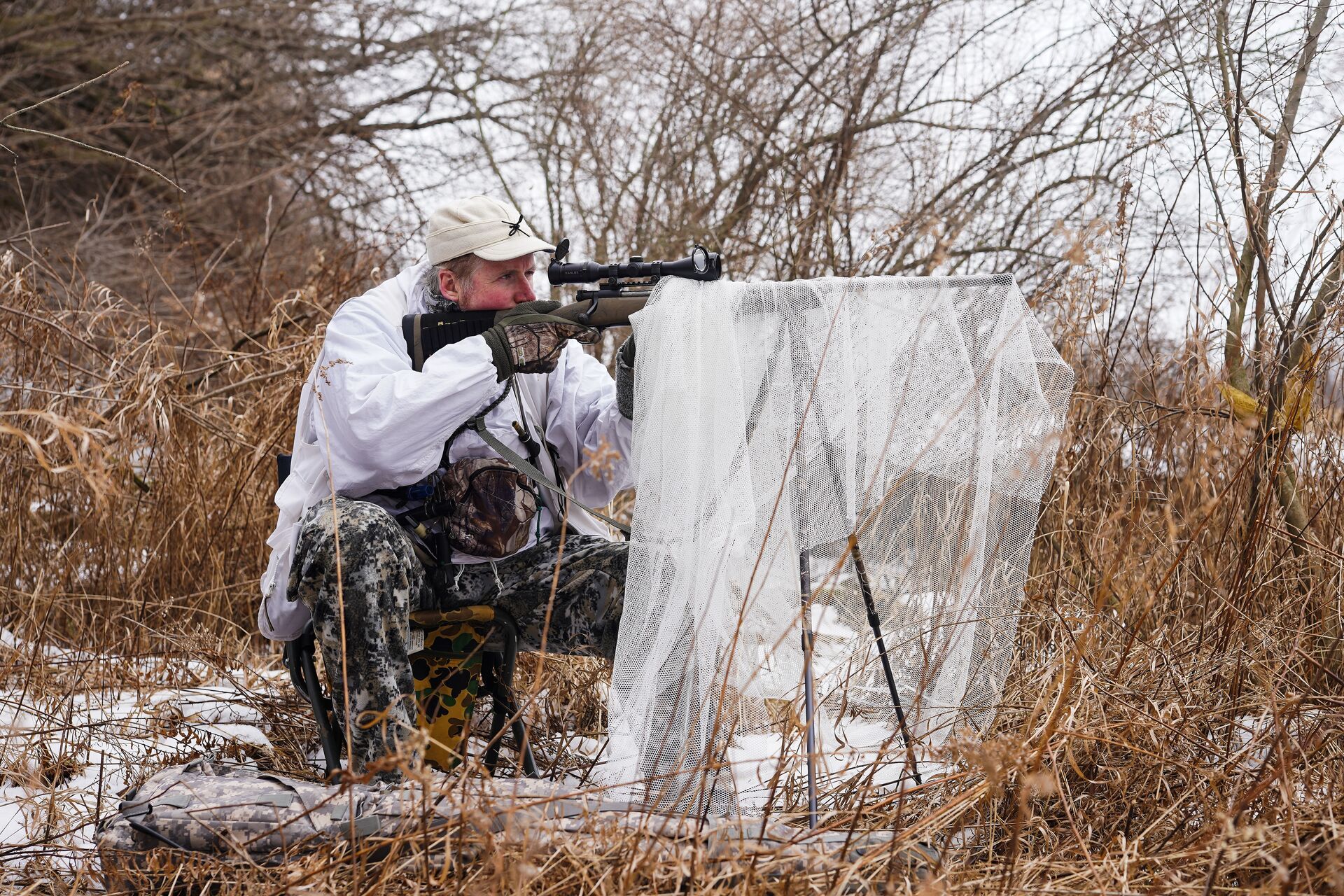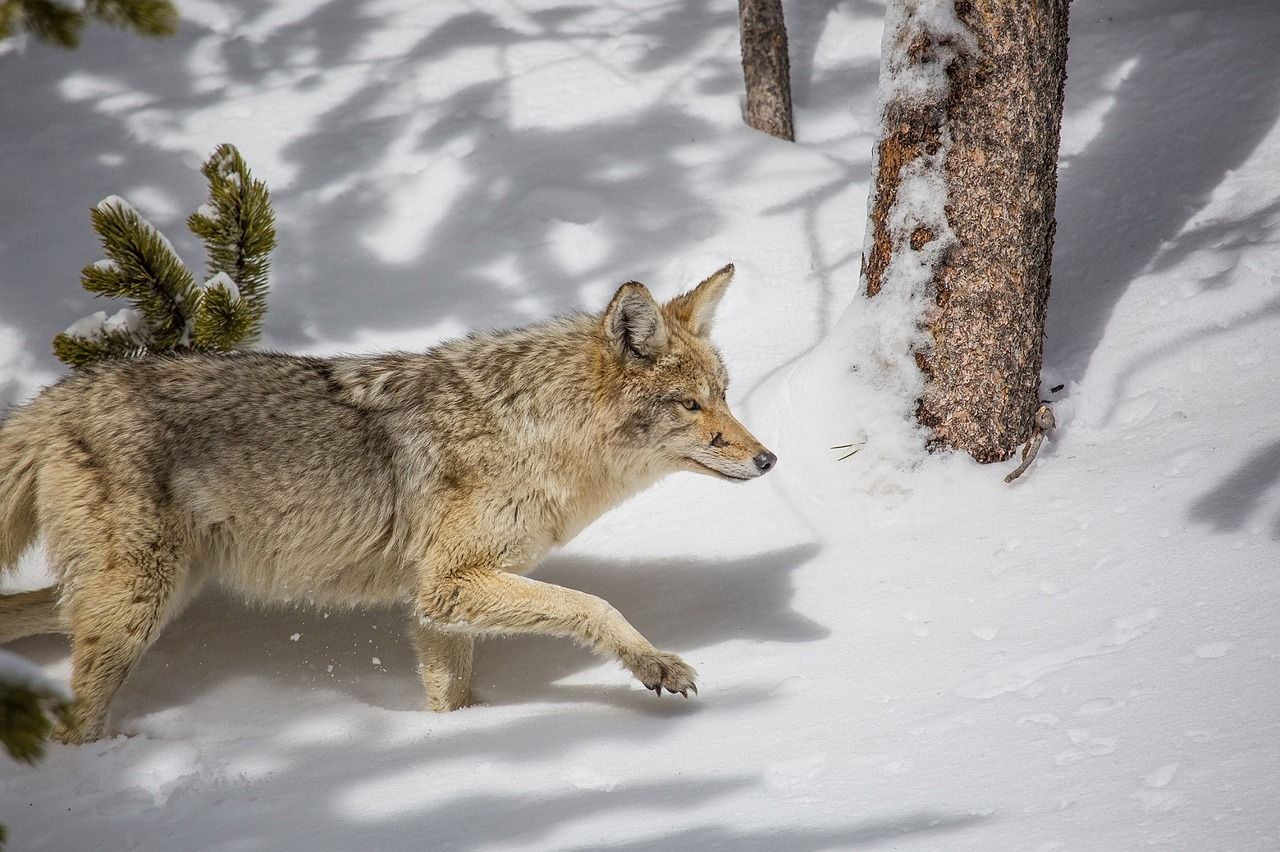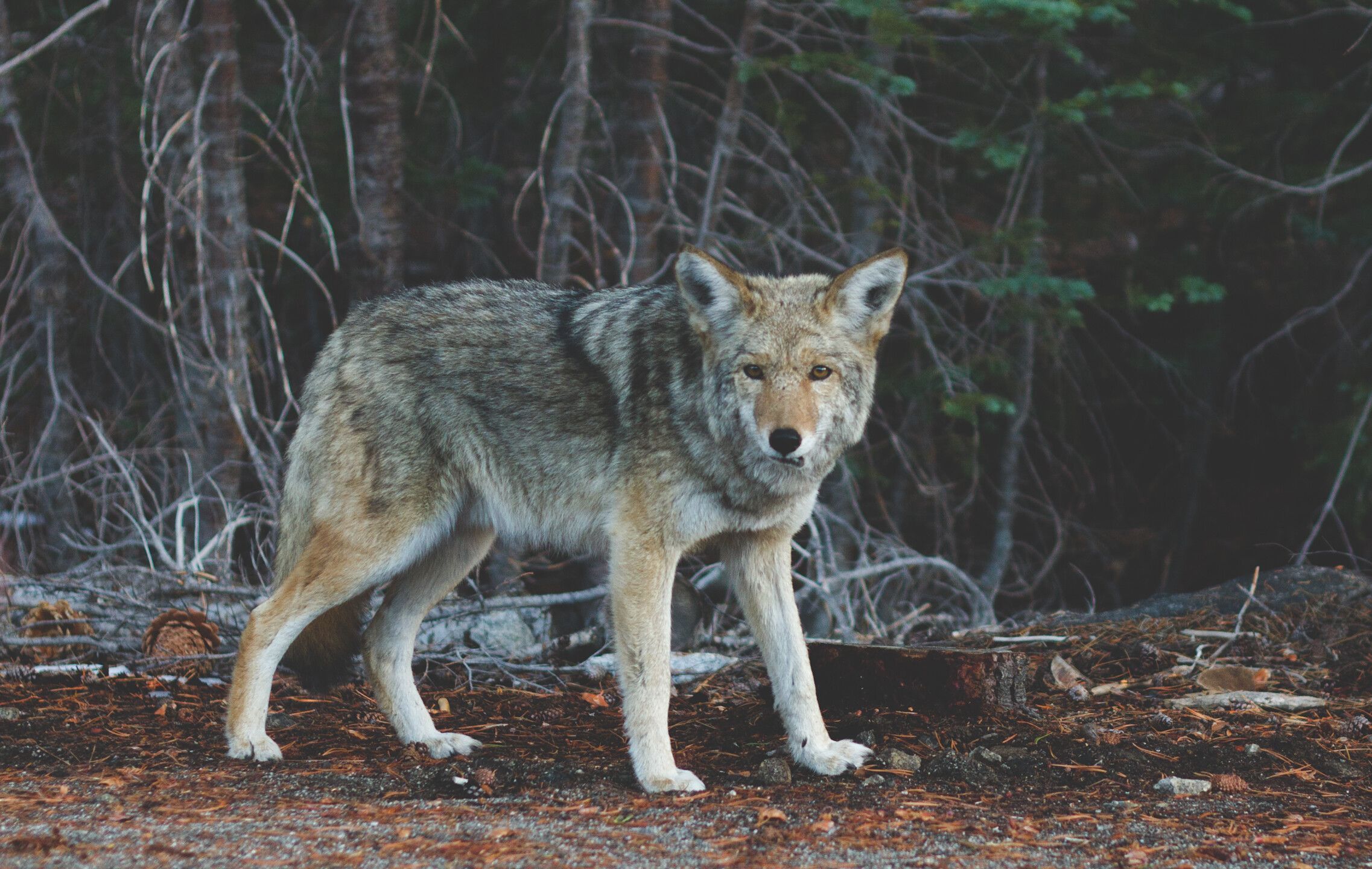Field Guide / Coyote
The HuntWise Coyote Hunting Guide

17 Minute Read
It's time to hunt the hunter. Outsmarting the ever-adaptable and elusive coyote is one of the most challenging hunts you can embark on.
So, what's the best approach? Why do we hunt coyote? What are the best tools and strategies for successfully hunting coyotes?
We have answers to these questions!
Today, we share our ultimate coyote hunting guide, including our best expert insights into hunting this predator. After extensive research, scientific data, and real-life experiences from hunters in the field, we have made this ultimate guide to teach you everything you need to know about coyote hunting.
In this article, we will give you the tools, tactics, and knowledge you need to take down these elusive creatures. Utilize coyote hunting in the off-season to hone your hunting skills and stay in shape!
Why You Should Hunt Coyotes
After a long season of chasing turkey, whitetail, waterfowl, and upland birds, you might be ready for time to relax until cabin fever sets in.
Not exactly!
Winter is the time to hunt the predators. We spend most of the year managing game animals, but we must remember that predators also need management.
Coyotes are destructive and invasive; they spread disease and kill many fawns and calves. To put it simply, nature has a balance. Coyotes play a huge role in that balance.
Success Requires a Strategy
For success when hunting these predators, the concept is simple:
- Attract coyotes with the sound of prey in distress
- Locate them
- Take a breath
- Execute the shot
To accomplish this strategy, start by understanding coyote behavior. Then, gather the gear you need (including the HuntWise app) and get out in the field.
Chapter 1: Understanding Coyotes and Their Behavior
A good hunter knows its prey: Their habits, habitat, and behaviors.
These variables come into play as you set your plan to outsmart coyotes in their own territory. Hunters must learn what the animals like or don't like, their seasonal food supply, and how they will react to new, unfamiliar scents and sounds.
What Coyotes Eat
A coyote's diet changes throughout the year. Three-quarters of a coyote's diet consists of small mammals such as mice, rabbits, rats, and squirrels. The rest consists of fruits, birds, eggs, vegetables, insects, and fish.
They will eat almost anything they can get their paws on.
In the winter, food becomes more sparse. During this time, coyotes rely more heavily on mice, rabbits, and deer. The amount of what they eat will depend on the size of the pack and how many alphas there are.
What could this kind of diet and a growing population of coyotes do to specific wild game populations such as deer and turkey? Without controlling the coyote population, deer and turkey numbers will dwindle, leaving fewer animals to hunt and be part of a healthy ecosystem.
Coyote Behaviors
There are three distinct coyote behaviors: Resident, disperser, and transient.
- Alpha males encourage the young ones to leave the pack, making them "dispersers."
- Transient coyotes are always on the move, making them hard to pattern and challenging to hunt.
- Resident coyotes belong to the pack and stick to a smaller territory than dispersers or transients.
Of the three behaviors, resident coyotes are much easier to kill. Their patterns are more consistent for hunters to learn and target for a successful hunt.
Over the last several years (depending on location), the deer population has grown plentiful, leading to increasing coyote numbers. In many areas, more coyotes then led to a decrease in deer herds.
Leveling both deer and coyote populations is a difficult balance. However, hunting coyotes assists in this maintenance.
Coyotes Are Smart With Super Senses
Coyotes are highly intelligent! These animals spend their entire life hunting and approaching every scenario they enter with caution. They know what they are walking into when stalking their prey.
Coyotes can smell even when they exhale. When scouting, planning, and hunting, remember that coyotes can hear and smell almost everything: a distant cough or a zipper on your jacket.
They are also sneaky and can outsmart hunters who don't plan ahead and study their behaviors.
Chapter 2: Why Hunting Coyotes Is Important
As deer populations decline and calves and fawns go missing, it could be because the coyote population is increasing – and it will only get worse.
During a recent whitetail hunting season, we learned of a buck that was tracked and found chewed up by coyotes by the time the hunter could retrieve it. Both hindquarters were ripped to shreds. Coyote tracks around the animal were the only evidence of what happened.
To avoid these situations and other issues that arise when coyote populations grow out of control, it's important to hunt coyotes.
Manage the Coyote Population
Coyotes are predators with little to no threat to them. So, who manages their population like they manage deer, rabbits, and other populations?
This topic is often up for debate. The truth is that anything in life, especially nature, requires balance. Coyotes can significantly impact wild game and farm animal populations if not managed properly.
Especially in the winter months, when food is scarce, coyotes will find easy prey in domestic animals or other wild game. For example, for most cattle farmers, February is calving season, and calves fall into a coyote's diet. Without vigilantly keeping coyotes at bay, farmers and ranchers will lose valuable calves to hungry coyotes.
Coyotes are quick to adapt and reproduce, and their numbers continually grow. In the West, they also interbreed with wolves, creating a new breed of predator called "coywolves."
A female coyote has the potential to birth up to 120 pups in her lifetime. If this rapid reproduction isn't managed properly, you can imagine the damage coyotes will do to wild game populations.
The Coyote Effect on the Wild Game Population
Coyote breeding season is January through March. The pups are born in the spring, along with many other new offspring, such as whitetail fawns, elk calves, and mule deer fawns.
The first two weeks of a fawn's life are the most vulnerable since they aren't strong or fast. This makes them easy prey for coyotes looking for food to feed their pups and pack.
Additionally, the whitetail fawn habitat has depleted over the years. In some areas, the doe population has increased without a comparable increase in the buck population. What does this mean for coyotes and fawns?
If you have a large doe population with a low amount of whitetail bucks, this can create challenges when the whitetail population needs to increase. For example, if you have 15 does and two bucks in one specific area, the chances of those does being bred in early fall and then again in late fall are high.
This spreads the fawning process out, making them easier targets. Managing animal populations is never a cut-and-dry topic with simple solutions.
Coyotes Spread Disease
Did you know that coyotes can carry a variety of diseases? Anytime they roam or pack swap, they could be spreading these diseases.
Some examples of what they carry include canine hepatitis and canine distemper. These diseases are lethal to domestic dogs. Additionally, parasites, ticks, fleas, and worms can cause flesh-eating mange - very common for coyotes.
Since coyotes can travel up to 100 miles, imagine the diseases they could spread in that area.
Pelts Can Generate Extra Money
What do you do with coyotes after you hunt them? Some dispose of the carcass, and others trade the pelts to their local trapper.
When pelts are in their prime and not rubbed (from the breeding season) or mangey, you can make some good money selling them. The fur market is comparable to the stock market, meaning it's constantly changing. However, there is money when the demand is there.
If you're considering selling coyote pelts, learning how to skin your own hides can be worthwhile. It isn't too difficult, but it does take some practice. The less damage to the pelt, the better.
Chapter 3: When and Where to Hunt Coyote
You don't want to waste time hunting areas that don't have coyotes. So, it will be crucial to take what you've learned about their food sources and habitat and use that information to locate good hunting areas.
What Time Of Year or Day Do You Hunt Coyotes?
You can typically hunt coyotes all year round, depending on your local laws and regulations. If you're not sure where to find information about coyote regulations in your area, the HuntWise app can help!
If you're looking for quality fur from your coyote kill, winter will be ideal for your hunt since they have thicker fur during this time to keep them warm. Coyotes are nocturnal hunters by nature, making dawn and dusk the optimal hunting times. However, as winter progresses, coyotes become less nocturnal in their search for food, so you're more likely to see them during the day.
How To Find Public Land and Access to Private Land
The key to not over-pressuring coyotes is to increase the number of places you hunt. More options will also give you better quality hunting.
One way to do this is to get permission on private lands. Farmers might be more willing to give access because they tend to have a lot of issues with coyotes threatening their calves.
To gain access to more hunting areas, use the mapping and landowner features in the HuntWise app. You can see an overhead satellite image of the land and how it looks. Then, you can use the toolset in the app to get landowner contact information.
This toolset is like having a guide in your pocket. It shows you where the nearest public and private lands are, the wind and weather conditions, and how different variables will affect your hunt.
HuntWise is the most up-to-date and detailed mapping system for coyote hunters!
Mapping Out Your Coyote Hunting Spots
The more hunting areas you have, the better situation you'll put yourself in. You don't want the coyotes to get "call shy" or learn your tactics, so switching spots is a good method for successful hunts.
Additionally, when the wind or weather isn't in your favor, you can go to the spots that are, so you never waste time in the field or woods.
Chapter 4: Coyote Calls to Add to Your Gear
The right coyote calls can help you bring in these predators for the perfect shot. Use the right ones at the right time to outsmart a coyote and lure them in for your shot.
Types Of Coyote Calls
Electronic calls are great for making imitation sounds of animals. Most of them come preloaded with 50+ sounds and a built-in speaker. You can also add more sounds yourself by downloading them online.
Coyotes hunt their prey from downwind; because of how sound travels, place your electronic call upwind of where they may be traveling to lure them in.
Diaphragm and hand calls are great tools to diversify your calling sequences and use while on the move. The one downside is that to achieve the most success with these calls, you have to be relatively good at using them, as the coyotes will easily pick out the errors.
YouTube videos can be an excellent resource for learning how to use these coyote calls effectively.
Calling Tactics
It can be tricky to decide what sounds to use and when. So, until you've reached an advanced understanding of the coyote language, keep it simple.
Try to use natural language and sound sequences. Use calls that sound natural, like a distressed mouse, rabbit, or woodpecker. The biggest factors are volume control and the pitch of your sound. Some hunters have even used distressed monkey calls and had success.
It's all about the tonality. Coyotes are curious, but they aren't stupid. You want to attract their instinct. If something is high-pitched and in distress, that means an easier hunt for them.
Coyotes are also the most vocal in the winter during their breeding season. They are very territorial animals, so use calls that challenge their dominance, like male-to-male barking or howling.
Calling can take practice and a lot of trial and error. However, if you use real scenarios, you will have a high chance of success.
Coyote Hunting Without a Call
If you can't get your hands on coyote calls, you can use a carcass, roadkill, or bait to sit over. Again, you'll want to check your local laws and regulations, and this process can take a while.
Additionally, your scent can linger on a carcass for a few days, forcing you to wait for days or even weeks until the carcass is discovered by nearby coyotes, bringing them into a location for your kill.
Chapter 5: Coyote Hunting Gear
When chasing coyotes, having the right tools will make you more efficient and the experience of it more enjoyable. Once you gain some experience, you can develop a customized gear list that matches your hunting style and needs.
Until then, or if you're simply looking for ways to improve your gear before your next hunt, here are a few of our recommendations.
What To Wear Coyote Hunting
Don't feel stressed or obligated to buy a new hunting wardrobe to hunt coyotes. Keep it simple.
You don't want to be seen, heard, or scented when hunting any animal. Keeping that in mind, if you're hunting at night, wear dark, warm clothing that doesn't make a lot of noise. Then, if you're hunting in the daylight during the winter, it would be ideal to wear white while also staying quiet.
No matter when you hunt, try to blend in with the surroundings. Remember: HuntWise users gain exclusive discounts on gear, including optics and clothing!
Firearms for Coyote Hunting
There is no "one size fits all" setup when choosing a rifle and optics for coyote hunting. Considering terrain, style, and range will help make your decision.
Other factors, such as effectiveness, weight, and ease of moving to and from hunting spots, will influence your firearm and optic choice. You'll also want to check your local laws and regulations to determine what is legal or illegal to use.
Standard calibers such as a .223, .22-250, and .243 work great in open terrain. They're also fur-friendly with the right bullets if you plan to keep the pelts.
However, your deer rifle will work just fine, too. A shotgun would be the best choice if you plan on being in close-quarter or thick timber. Some rimfire offerings will work, but your shot placement will be critical.
Optics to Use for Coyote Hunting
Optics can get really expensive, really fast. So, don't feel the need to get the most expensive optics for coyote hunting. You can still get the job done without breaking the bank.
What you'll need depends on where and when you are hunting. A coyote light is a great entry-level light to utilize for coyote hunting. These lights come in three standard colors: white, red, and green. Each one has its pros and cons.
For example, the red lights give you a better eye shine on the animals and prevent fatigue in your own eyes. It's also the most affordable route to get into night hunting.
Thermal scopes or night vision can also give you an advantage. Thermal will provide good detection, while night vision helps with animal identification. Again, check your local laws and regulations regarding the optics you can and cannot use.
Additionally, a rangefinder helps gauge your shot distance, and having an adjustable turret on your scope can be useful for those long-distance shots.
Decoys
One of the benefits of using coyote decoys is to assure the animals that what they hear from your call is real. It will also draw their attention as they work their way in.
When you position the decoy, place it to the side and away from you. When the coyotes come to your calls, they will be wary; you don't want them to see or hear you.
Decoys are especially helpful during their breeding season. There are a few decoys to choose from, including one that mimics a coyote, rabbit or squirrel tails, or a wiggling rabbit in distress.
Again, coyotes will be focused on the decoy when they come in, proving that they are seeing what they have been hearing and making them less skeptical of you.
Shooting Sticks
Your gun setup will likely vary by season. However, this is mostly a personal preference.
In the fall or summer, you could use a bipod on your gun or simple shooting sticks to help you stabilize your gun. At night, some hunters use a tripod fixed to the gun for steady shooting and the ability to move it from spot to spot quicker and more efficiently.
Additional Coyote Gear
Some extra must-have items could include extra batteries for your electronic call or lights, an extra mouth call in case your electronic call fails (which does happen), and some hand warmers.
Another critical item is a coyote drag, especially if you have more than one coyote to drag out. This will free up your hands to carry out the rest of your gear.
Chapter 6: Coyote Hunting Strategies and Tactics
With your gear ready to go, you need to determine the best strategies and locations for a successful coyote hunt.
Scouting
Your scouting tactics will vary per state, but a general rule of thumb is to focus on areas that hold small game, birds, mice, and vermin or anywhere there is a good food supply for coyotes.
Check out areas with brushy creeks or river bottoms, swamps, and marshes. Cattle and dairy farms have calves and mice, and we know those make good meals for coyotes.
Try to locate a den or find fresh tracks. If you see coyotes in your deer hunting spots, chances are they will be there in winter, too. If deer or cows are moving, coyotes will be too.
In the summer, fresh-cut hay fields have a larger food supply, so hunting open fields and farms is ideal. In the winter, food is harder to find, so stick to areas that will hold deer and rabbits and look for good habitat.
Sit Still and Stay Quiet
Remember, coyotes have an excellent sense of sound and smell. Stealth is the first priority when you're in the field or woods and actively scouting or hunting.
Don't slam vehicle doors or talk above a whisper. Once you pick your spot, settle into a comfortable shooting position on a knoll or field edge that offers good visibility and cover – then be still and quiet.
Play The Wind
Call into the wind or with a crosswind, and always keep a good downwind shooting lane.
Coyotes will usually circle downwind of distress sounds. Keeping an obstacle at your back, like a creek or fence row, can help steer them into the best shooting lanes.
Wait a few minutes after setting up before calling. The approach is important: stay quiet and still.
How Long Should You Hunt Each Spot?
If they're around, most coyotes respond quickly once you begin calling, but give each set at least 20 to 45 minutes.
If no coyotes come to your calls, sneak back out, drive to another area at least a half-mile away, and repeat the process. You should be able to cover eight to ten good spots in a day of hunting, and odds are, if your setups are good, at least one of those spots will produce a shot.
Sneak in and sneak out a different day and try different sounds – no damage done. Coyotes travel miles daily, so you'll eventually cross paths with them at the best time for a successful kill.
Use HuntWise as Your Coyote Hunting Field Guide
Now that you have the knowledge and toolset you need to get out in the field and chase elusive coyotes; you can feel confident in your chances of success. This type of hunting will keep you sharp in the off-season and challenge you in new ways.
With the HuntWise app, you can maximize your time in the field and outsmart those coyotes by e-scouting land, marking spots where you see coyote activity, and forecasting the weather to pick the best days for your hunt. You'll also have access to land boundaries and owner information to help you get everywhere you need to be when tracking and hunting coyotes.
Content updated January 8, 2024.
Try HuntWise For Free
Start your risk-free 7-day trial now!
More Content Like This

Must-Have Coyote Hunting Gear for a Predator Hunt [A Top 10 List]
Coyote hunting can be a great off-season pursuit to get you off the couch and keep your woodsmanship skills sharp. Whether you are just getting started or a seasoned coyote calling enthusiast, every coyote hunter needs a few items to make the most of...Read More
Read More3 Simple Tips For Hunting Coyote In The Winter
Many avid whitetail hunters shift their focus to coyote hunting in winter. This time of year is generally referred to as the deer hunters' "off-season," and hunting coyotes after the whitetail season can be helpful for several reasons. Read More
Read MoreThe Best Time to Hunt Coyote (2025)
Coyotes are extremely smart animals with keen eyesight and a strong sense of smell. Hunting them during the prime winter months (November–February) can be your best bet for catching one of these creatures.Read More
Read More Coyote
CoyoteMust-Have Coyote Hunting Gear for a Predator Hunt [A Top 10 List]
By John Gay | 01/01/2025Coyote hunting can be a great off-season pursuit to get you off the couch and keep your woodsmanship skills sharp. Whether you are just getting started or a seasoned coyote calling enthusiast, every coyote hunter needs a few items to make the most of...Read More
Read More Coyote
Coyote3 Simple Tips For Hunting Coyote In The Winter
By Spencer Blanchard | 12/19/2023Many avid whitetail hunters shift their focus to coyote hunting in winter. This time of year is generally referred to as the deer hunters' "off-season," and hunting coyotes after the whitetail season can be helpful for several reasons. Read More
Read More Coyote
CoyoteThe Best Time to Hunt Coyote (2025)
By Teri Williams | 11/21/2025Coyotes are extremely smart animals with keen eyesight and a strong sense of smell. Hunting them during the prime winter months (November–February) can be your best bet for catching one of these creatures.Read More
Read More
1 of 3